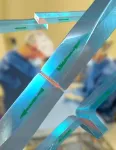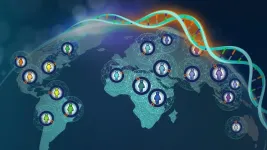A new glue, potentially also for you
A new bonding method enabling instant and effective adhesion of hydrogels has potential to broadly advance new biomaterials solutions for multiple unmet clinical needs.
By Benjamin Boettner
(Boston) — Hydrogels are versatile biomaterials conquering an increasing number of biomedical areas. Consisting of water-swollen molecular networks that can be tailored to mimic the mechanical and chemical features of various organs and tissues, they can interface within the body and on its outer surfaces without causing any damage to even the most delicate parts of the human anatomy. Hydrogels are already used in clinical practice for the therapeutic delivery of drugs to fight pathogens; as intraocular and contact lenses, and corneal prostheses in ophthalmology; bone cement, wound dressings, blood-coagulating bandages, and 3D scaffolds in tissue engineering and regeneration.
However, attaching hydrogel polymers quickly and strongly to one another has remained an unresolved unmet need as traditional methods often result in weaker adhesion after longer-than-desired adhesion times, and rely on complex procedures. Achieving rapid adhesion of polymers could enable numerous new applications, including, for example, hydrogels whose stiffness could be finely tuned to better conform to specific tissues, on-demand encapsulation of flexible electronics for medical diagnostics, or the creation of self-adhesive tissue wraps for hard-to-bandage parts of the body.
Now, scientists at the Wyss Institute for Biologically Inspired Engineering at Harvard University and Harvard John A. Paulson School of Engineering and Applied Sciences (SEAS) have created a simple and versatile method to instantly and effectively bond layers made of the same or different types of hydrogels and other polymeric materials, using a thin film of chitosan: a fibrous, sugar-based material derived from the processed outer skeletons of shellfish. They successfully applied their new approach to several unsolved medical problems, including the local protective cooling of tissues, sealing of vascular injuries, and prevention of unwanted “surgical adhesions” of internal body surfaces that should not stick to each other. The findings are published in the Proceedings of the National Academy of Science (PNAS[BB1] ).
“Chitosan films with their abilities to effectively assemble, fine-tune, and protect hydrogels in the body and beyond, open numerous new opportunities to create devices for regenerative medicine and surgical care,” said senior author and Founding Wyss Institute Core Faculty member David Mooney, Ph.D. “The speed, ease, and effectiveness with which they can be applied makes them highly versatile tools and components for in vivoassembly processes in often short time-windows during surgeries, and the simple fabrication of complex biomaterial structures in manufacturing facilities.” Mooney also is the Robert P. Pinkas Family Professor of Bioengineering at SEAS.
Engineering a new bond
Over the past years, Mooney’s team at the Wyss Institute and SEAS has developed “Tough Adhesives,” a collection of regenerative medicine approaches that use stretchable hydrogels to facilitate wound healing and tissue regeneration by strongly sticking to wet tissue surfaces and conforming to tissues’ mechanical properties. “Precisely formulated Tough Adhesives and non-adhesive hydrogels give us and other researchers new opportunities to improve patient care. But to take their functionalities one or even multiple steps further, we wanted to be able to combine two or more hydrogels in more complex assemblies, and to do this fast, safely, and in a simple process,” said co-first author and former Wyss Research Associate Benjamin Freedman, Ph.D., who spearheaded several Tough Adhesive developments with Mooney. ”Existing methods to instantly bond hydrogels or elastomers had striking disadvantages because they relied on toxic glues, the chemical functionalization of their surfaces, or other complex procedures.”
Through a biomaterial screening approach, the team identified bridging films completely made of chitosan. Chitosan is a sugary polymer that can be easily made from the chitin shells of shellfish and has already found its way into wide-ranging commercial applications. For example, it is currently used to treat seeds and as a biopesticide in agriculture, to prevent spoilage in winemaking, in self-healing paint coatings, and in medical wound management.
The team found that chitosan films achieved rapid and strong bonding of hydrogels through chemical and physical interactions that are different from those involved in traditional hydrogel bonding methods. Instead of creating new chemical bonds based on the sharing of electrons between individual atoms (covalent bonds), induced by a tiny shift in pH, chitosan’s sugar strands rapidly absorb water residing between hydrogel layers and entangle themselves with the polymer stands of hydrogels, forming multiple bonds via electrostatic interactions and hydrogen bonding (non-covalent bonds). This results in adhesive forces between hydrogels that significantly exceed those created through traditional hydrogel bonding approaches.
First applications
To demonstrate the breadth of potential of their new method, the researchers focused on very different medical challenges. They showed that Tough Adhesives modified with chitosan films could now be easily wrapped around cylindrical shapes like an injured finger as self-adhering bandages to provide improved wound care. Due to the high water content of chitosan-bonded hydrogels, their application also allowed the local cooling of underlying human skin, which in the future could lead to alternative burn treatments.
The researchers also wrapped hydrogels (tough gels) whose surfaces were modified with thin chitosan films seamlessly around bowel, tendon, and peripheral nerve tissue without bonding to the tissues themselves. “This approach offers the possibility to effectively insulate tissues from each other during surgeries, which otherwise can form ‘fibrotic adhesions’ with sometimes devastating consequences. Their prevention is an unmet clinical need that commercial technologies cannot adequately address yet,” explained Freedman.
In another application, they layed down a thin chitosan film on a tough gel that was already placed on an injured pig aorta ex vivo as a wound sealant to increase the overall strength of the bandage, which was exposed to the cyclical mechanical forces of blood pulsing through the vessel.
“The numerous possibilities emerging from this study by Dave Mooney’s group add a new dimension to the engineering of biomedical hydrogel devices, which could lead to elegant solutions for urgent unmet problems in regenerative and surgical medicine that many patients could benefit from,” said Wyss Founding Director Donald Ingber, M.D., Ph.D., who is also the Judah Folkman Professor of Vascular Biology at Harvard Medical School and Boston Children’s Hospital, and the Hansjörg Wyss Professor of Bioinspired Engineering at SEAS.
Additional authors on the study are co-first author Juan Cintron Cruz, Mathew Lee, and James Weaver at the Wyss Institute and SEAS; Phoebe Kwon, Haley Jeffers, and Daniel Kent at SEAS; and Kyle Wu at Beth Israel Deaconess Medical Center in Boston. The study was supported by the Wyss Institute at Harvard University, the National Institutes of Health’s National Institute on Aging (under award# K99/R00AG065495), and the Harvard GSAS Research Scholar initiative.
PRESS CONTACTS
Wyss Institute for Biologically Inspired Engineering at Harvard University
Benjamin Boettner, benjamin.boettner@wyss.harvard.edu, +1 617-432-8232
###
The Wyss Institute for Biologically Inspired Engineering at Harvard University (www.wyss.harvard.edu) is a research and development engine for disruptive innovation powered by biologically-inspired engineering with visionary people at its heart. Our mission is to transform healthcare and the environment by developing ground-breaking technologies that emulate the way Nature builds and accelerate their translation into commercial products through formation of startups and corporate partnerships to bring about positive near-term impact in the world. We accomplish this by breaking down the traditional silos of academia and barriers with industry, enabling our world-leading faculty to collaborate creatively across our focus areas of diagnostics, therapeutics, medtech, and sustainability. Our consortium partners encompass the leading academic institutions and hospitals in the Boston area and throughout the world, including Harvard’s Schools of Medicine, Engineering, Arts & Sciences and Design, Beth Israel Deaconess Medical Center, Brigham and Women’s Hospital, Boston Children’s Hospital, Dana–Farber Cancer Institute, Massachusetts General Hospital, the University of Massachusetts Medical School, Spaulding Rehabilitation Hospital, Boston University, Tufts University, Charité – Universitätsmedizin Berlin, University of Zürich, and Massachusetts Institute of Technology.
The Harvard John A. Paulson School of Engineering and Applied Sciences (http://seas.harvard.edu) serves as the connector and integrator of Harvard’s teaching and research efforts in engineering, applied sciences, and technology. Through collaboration with researchers from all parts of Harvard, other universities, and corporate and foundational partners, we bring discovery and innovation directly to bear on improving human life and society.
END




